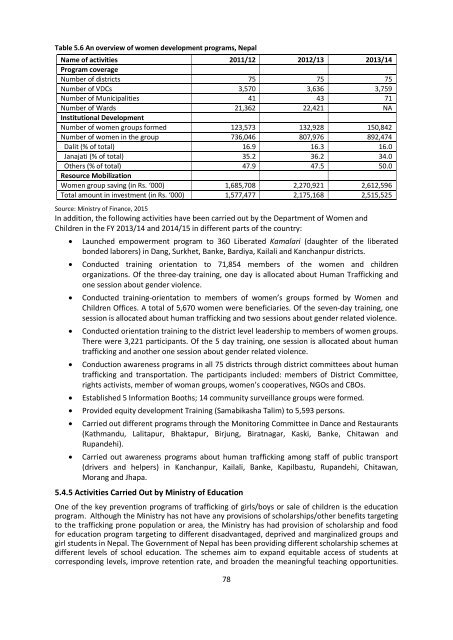TRAFFICKING IN PERSONS
397604438Trafficking_in_Persons_National_Report_2013-15
397604438Trafficking_in_Persons_National_Report_2013-15
You also want an ePaper? Increase the reach of your titles
YUMPU automatically turns print PDFs into web optimized ePapers that Google loves.
The share of children from the disadvantaged social groups - Dalit and Janajati - has also been<br />
encouraging in recent years (Table 5.9). Given the 12.6 percent share of Dalit population in Nepal,<br />
the share of Dalit students at Basic Level has overrepresented while it is lower in case of secondary<br />
level. In case of Janajati, their share at both Basic Level and Secondary Level is highly satisfactory<br />
given their share of total population of 37 percent in Nepal 12 .<br />
Table 5.9 Share of Dalit and Janajati at Basic Level (1-8 grades) and Secondary Level (9-10 grades), Nepal (in %)<br />
Year Dalit Janajati<br />
Basic Level Secondary Level Basic Level Secondary Level<br />
2004 12.5 8.1 25.0 30.2<br />
2005 18.3 5.1 35.5 31.8<br />
2006 15.3 5.3 36.9 29.9<br />
2007 16.9 6.4 40.8 37.0<br />
2008 18.1 7.8 41.0 40.7<br />
2009 18.2 8.6 39.3 39.5<br />
2010 19.6 10.0 39.1 40.8<br />
2011 19.7 10.5 38.5 40.4<br />
Source: Department of Education (2012).<br />
Drop-Out Rates - As discussed in Chapter 2 (Child Trafficking Section), drop-out rates of school<br />
education are associated with trafficking of children in Sindhupalchok and Nuwakot districts<br />
(childreach.org.uk). Drawing upon data from Department of Education, following references may be<br />
drawn: First, although the proportions of drop-outs rates have been declining for both basic level<br />
and secondary level, the numbers are very substantial. For example, the number of drop-out<br />
students in basic level remained more than 425,000 each year from 2006 to 2011 and this number<br />
ranges as low as 40,000 to as high as 70,000 for Secondary level. It can be confirmed that, on the<br />
average, 500,000 students enrolled in grades one to 10 tend to drop-out each year in Nepal. Second,<br />
there is no significant variation in drop-out rates by gender irrespective of level of education. Third,<br />
drop-out rates tend to increase as the levels of education increases (Table 5.10).<br />
Table 5.10 Drop-out rates by basic level (1-8 grade) and secondary level (9-10 grade), Nepal<br />
Year Basic Level Secondary level<br />
Girls Boys Total Girls Boys Total<br />
Percent<br />
2006 8.0 7.6 7.8 NA NA NA<br />
2007 7.8 7.1 7.4 6.2 6.4 6.3<br />
2008 11.4 9.0 10.1 10.6 11.5 11.1<br />
2009 7.3 6.9 7.0 8.1 9.4 8.8<br />
2010 6.2 6.6 6.4 8.1 9.2 8.7<br />
2011 6.3 6.6 6.5 6.9 6.8 6.9<br />
Number<br />
2006 222,877 230,298 453,663 - - -<br />
2007 221,311 214,769 433,805 19,142 23,196 42,285<br />
2008 350,504 285,712 631,167 35,792 43,438 79,407<br />
2009 236,486 225,323 455,356 30,793 38,558 69,551<br />
2010 207,033 218,634 425,721 32,093 38,244 70,636<br />
2011 209,422 215,912 428,712 29,100 29,024 58,551<br />
Note: As the number of drop-outs is not provided by data of Department of Education, the Research team estimated the<br />
numbers of drop-outs by multiplying the proportion of drop-outs and total number of enrolments by sex in the<br />
corresponding year.<br />
Source: Department of Education (2012).<br />
12<br />
According to the Population census 2011, the total population of Nepal was 26,494,468. Of which, Dalit accounted for<br />
12.6 percent (Hill Dalit 8.1% and Terai/Madheshi Dalit 4.5); Janajati accounted for 35 percent (hill Janajati 27.3% and<br />
Terai/Madheshi Janajati 7.7%).<br />
80


